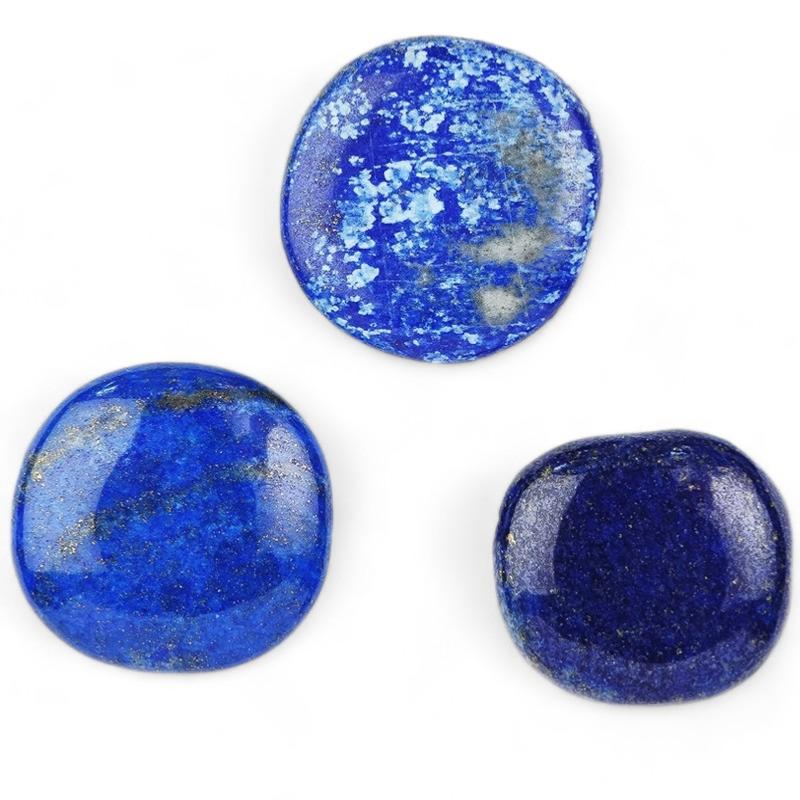Lapis lazuli pebble Afghanistan AB
LAP-G-01
- Regular price
-
9,90€ - Regular price
-
- Sale price
-
9,90€
Couldn't load pickup availability
Learn more
LAP-G-01
Origin: Afghanistan
Grade: AB
Dimensions:
About 20-30mm
Weight:
Between 10 and 20g
Origin:
Afghanistan
Grade:
AB = standard
20-30mm lapis lazuli pebble
Sold individually.
Patterns and colors may vary from stone to stone.
Lapis lazuli is one of the stones that has the most legends and myths about it. The first traces of this fabulous blue stone date back to at least 7,000 years BC.
Lapis lazuli is a metamorphic rock with variations in its composition. Belonging to the silicate family, lapis lazuli is made up of limestone and about 20 to 40% lazurite. It is this presence of lazurite that gives the stone its beautiful deep blue color.
In addition, it also contains veins of pyrite, which give it yellow sparkles. This pyrite has sometimes been confused with gold. Sodalite, calcite and augite are also present in this stone.
Lapis lazuli has a low hardness of 5 to 5.5 on the Mohs scale. For comparison, diamond has a hardness of 10 on the same scale.
Lapis lazuli is a beautiful blue stone. The fewer pyrite veins or calcite chips it contains, the more valuable it is.
The name of this stone comes from the Latin "lapis” meaning stone and "lazuli” meaning azure. Literally, the translation of its name is "azure stone". However, the stone has had other names.
It has even been confused with sapphire. The greatest geologists and naturalists have made the mistake. This is the case of Theophrastus (371 - 288 BC), Greek philosopher and naturalist, Pliny the Elder (23 - 79 AD), Roman naturalist writer and Georgius Agricola (1494 - 1555), father of mineralogy and metallurgy. The latter evoke a star sapphire because of this magnificent blue and these golden spots.
Many archaeological sites have shed light on the existence of this stone since 7,000 BC. Many objects, jewelry, amulets and other daggers are discovered. It seems that this incredible stone was the object of trade between Afghanistan, Mesopotamia and Egypt.
During the Bronze Age (-2700 to -900 years BC), lapis lazuli was nicknamed "the stone of stones" by the Sumerians. Superb artifacts have been found in the tombs of the Royal Cemetery of Ur in Iraq and in the Royal Palace of Ebla in Syria. It evokes the celestial vault and is reserved for the elites, princes and gods.
In the Middle East and Egypt, all kinds of objects are then made (animal statuettes, seals, amulets, and jewelry). Lapis lazuli then becomes a stone with powerful virtues. Stronger than evil, this stone is the symbol of perfection. It becomes the incarnation of spiritual, political and physical power. Then, it is used to represent the eyes of the divinities. Moreover, Tutankhamun's mask has lapis lazuli encrusted at the eyebrow level.
The Romans attributed aphrodisiac benefits to it and used it as an antidote against insect or snake bites and stings. Crushed, this stone is used as a cosmetic.
In Europe, in the Middle Ages, lapis lazuli was ground to make ointments with strong healing powers. From 1400, lapis lazuli was used as a pigment for painting. It can be found in the sky of the Sistine Chapel in Rome. This pigment has a relatively high cost and will be replaced by a synthetic pigment in the 19th century.
Today, this lapis lazuli pigment is still available and can reach the price of €20,000 per kg. The price varies depending on its quality and origin.
The main deposits are located in Afghanistan, Egypt, etc.
Lapis lazuli is a stone of openness to others. It develops communication and facilitates friendly exchanges. It thus allows one to overcome one's shyness. It encourages one to express oneself without restraint, without fear of reproaches or criticism.
This stone provides the necessary assurance to take charge of one's life and no longer be dominated by anyone. It restores self-confidence and generates emotional healing.
Blue represents serenity: this stone brings calm, represses negative emotions and fights against stress. Lapis lazuli helps to combat anxiety, buried fears and past traumas. It is recommended during episodes of intense sadness.
Lapis lazuli is a stone of intellectual and artistic stimulation. It develops imagination, ingenuity and creativity. Thus, it is perfectly suited to all people who need to create (artists, writers, authors, composers, etc.).
This stone allows its wearer to spread tenderness, kindness and happiness. It facilitates introspection and helps to identify psychological problems. It gives the strength to fight the hidden causes of the discomfort felt.
Lapis lazuli is a valuable aid during complicated periods, such as divorce, loss of a loved one, professional dismissal, etc.
Features
Color :
- Blue
Astrological sign:
- Virgin
- Sagittarius
Stone Type:
- Rolled Stones
Age :
Gender :




Lapis lazuli pebble Afghanistan AB
- Regular price
-
9,90€ - Regular price
-
- Sale price
-
9,90€
-
100% SECURE PAYMENT
Paypal, credit card, check, transfer
-
FREE DELIVERY
from 40€ purchase
-
SATISFIED OR REFUNDED
14 days to change your mind
-
CUSTOMER SERVICE AVAILABLE
contact@laboiteacailloux.com
to receive all our offers, good deals and new products from La Boite à Cailloux





